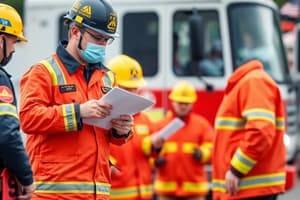Podcast
Questions and Answers
What is the first step in conducting a risk assessment?
What is the first step in conducting a risk assessment?
- Evaluating the risks associated with each hazard
- Deciding on control measures to implement
- Identifying the hazards present (correct)
- Reviewing the activity and working environment
How should one evaluate the risks associated with each hazard?
How should one evaluate the risks associated with each hazard?
- By assessing the likelihood and possible severity of harm (correct)
- By identifying all possible hazards
- By implementing control measures immediately
- By reviewing the activity and working environment
What should be done if control measures are not in place for identified risks?
What should be done if control measures are not in place for identified risks?
- Work should not start or continue until those risks have been controlled (correct)
- Work should start or continue as planned
- Control measures are not necessary if hazards are identified
- Control measures need to be reviewed by an external party
What is a hazard in the context of risk assessment?
What is a hazard in the context of risk assessment?
Who might be harmed by identified hazards in a workplace?
Who might be harmed by identified hazards in a workplace?
What is the purpose of evaluating risks in a risk assessment?
What is the purpose of evaluating risks in a risk assessment?
What are the two main factors considered in a risk matrix for determining the overall risk rating of a hazard?
What are the two main factors considered in a risk matrix for determining the overall risk rating of a hazard?
Which category does 'Minor injury' fall into in the consequences grouping of a risk matrix?
Which category does 'Minor injury' fall into in the consequences grouping of a risk matrix?
What does ALARP stand for in the context of risk assessment?
What does ALARP stand for in the context of risk assessment?
What is the objective of carrying out a risk assessment?
What is the objective of carrying out a risk assessment?
What does corrective action refer to in the context of incident management?
What does corrective action refer to in the context of incident management?
What is a crucial factor to consider when planning workplace inspections for identifying hazards?
What is a crucial factor to consider when planning workplace inspections for identifying hazards?
Flashcards are hidden until you start studying
Study Notes
- A risk matrix is used during a risk assessment to measure the level of risk by considering the consequence/severity and likelihood of injury to a worker after being exposed to a hazard.
- The risk matrix helps determine the overall risk rating of the hazard by answering two questions: Consequences and Likelihood.
- Consequences can be grouped into four categories: Fatality, Major or serious injury, Minor injury, and Negligible injuries.
- The likelihood of a hazard causing worker injury can be grouped into four categories: Very likely, Likely, Unlikely, and Highly unlikely.
- Risk assessment reasons for review include residual risk, ALARP (As Low As Reasonably Practicable), reasonably practicable, social political and cultural influences, OH&S risk assessment, strategic direction of the organization, and factors that influence risk tolerability or acceptability.
- The objectives of carrying out a risk assessment are to identify hazards, assess the risk, understand the likelihood, implement control measures, and manage the risk.
- Correction refers to putting the situation right after an incident has occurred, while corrective action is a long-term solution to prevent a recurrence of the issue. Preventive action is a proactive measure to prevent an incident before it happens.
- Sources of information for a risk assessment include internal records such as incident reports, hazard identification records, risk assessments, and safety training records, and external sources such as material safety data sheets, machine maintenance instructions, and regulatory body websites.
- Workplace inspections are crucial for identifying hazards, assessing risks, and implementing control measures. Factors to consider when planning inspections include the frequency, type, competent inspection staff, resources, inspection criteria, responsibilities and authorities, and performance indicators.
- Incident investigation is an important part of the OHS management system, with the objective of identifying the root cause of the incident, suggesting control measures, and improving safety culture.
- Incident investigation can influence safety culture by providing an opportunity to learn from incidents, improving communications, and fostering a proactive approach to safety.
- Incident investigation prerequisites include deciding who will carry out the investigation, the responsibilities for carrying out the investigation, incident site preservation, first aid and medical treatment, witness volunteers or not, and the facts and data reliability.
- Good interviewing principles from witnesses include building a rapport, relevant questions only, elaborating and explaining, remembering the incident perspective only, open-ended questions, patience, and human psychology.
- The contents of an effective investigation report include the date, time, and location of the incident, details of any injuries, ill health, or damages, a description of the incident, relevant documents, and identification of the situations and practices which resulted in the incident.
Studying That Suits You
Use AI to generate personalized quizzes and flashcards to suit your learning preferences.
Related Documents
Description
Test your knowledge of risk assessment, incident investigation, and reporting in occupational health and safety management systems. Learn about hazard identification, measuring and monitoring equipment requirements, and steps for conducting risk assessment.



